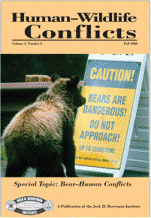Center, Internet, Wildlife Damage Management

Human–Wildlife Interactions
Date of this Version
2008
Document Type
Article
Abstract
Expansion of black-tailed prairie dog (Cynomys ludovicianus) colonies on public and private lands can result in damage to property. Physical barriers to prairie dogs can be used to minimize human–wildlife conflicts. We evaluated 17 existing barriers in the Fort Collins and Boulder, Colorado, areas. Most barriers were made of a single row of vinyl material; these barriers sustained high levels of damage, primarily from wind, and were frequently breached by prairie dogs digging underneath them. Barriers that included a vegetation and a vinyl barrier or a double-vinyl barrier were wind damaged and breached less frequently than the single-vinyl barriers. Sturdy panels of corrugated metal or fiberglass, extending about 76 cm above and 76 cm below the ground surface, were not damaged by wind and were rarely breached by prairie dogs. These barriers were about twice the cost of the single-vinyl barriers, but were much more durable and more effective in preventing prairie dog colony expansion.


Comments
Published in Human-Wildlife Conflicts Volume 2, Number 2, Pages 206–211, Fall 2008. Published and copyright by Jack H. Berryman Institute. http://www.berrymaninstitute.org/journal/index.html